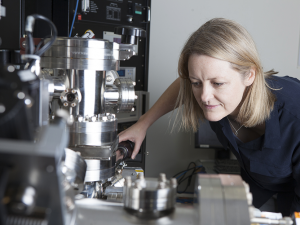 Dr Yi-Sheng Chen and Prof. Julie Cairney, working in partnership with CITIC Metals, have used Microscopy Australia’s state-of-the-art cryogenic atom probe at the University of Sydney to directly observe hydrogen at specific microstructures in steels. They were able to ‘see’ the complicated interactions of hydrogen atoms with different kinds of defects in the steel. The fact that hydrogen is the smallest and lightest of the elements makes these observations extremely challenging, even with such a powerful instrument.
Dr Yi-Sheng Chen and Prof. Julie Cairney, working in partnership with CITIC Metals, have used Microscopy Australia’s state-of-the-art cryogenic atom probe at the University of Sydney to directly observe hydrogen at specific microstructures in steels. They were able to ‘see’ the complicated interactions of hydrogen atoms with different kinds of defects in the steel. The fact that hydrogen is the smallest and lightest of the elements makes these observations extremely challenging, even with such a powerful instrument.
Although non-microscopic techniques can, and have, identified hydrogen accumulation in metals, they do not allow researchers to work out exactly where the hydrogen atoms go and what kind of features they associate with. From their experiments, the researchers found that hydrogen accumulates at microstructures called dislocations, and at the boundaries between individual crystals. This accumulation causes structural changes that weaken the steel.
The researchers also found the first direct evidence that clusters of niobium carbide within the steel crystals trap hydrogen in such a way that it can’t readily move to the dislocations and crystal boundaries to cause embrittlement. These carbides could be key to the informed design of new, embrittlement-resistant steels that could help smooth the way towards a hydrogen-fuelled future.
Ref. Yi-Sheng Chen et al., Science, 10 Jan 2020 Vol. 367, Issue 6474, pp. 171-175
DOI: 10.1126/science.aaz0122
Array
January 10, 2020